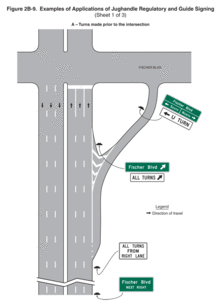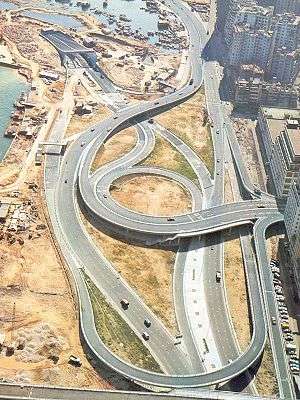Jughandle

A jughandle is a type of ramp or slip road that changes the way traffic turns left at an at-grade intersection (in a country where traffic drives on the right). Instead of a standard left turn being made from the left lane, left-turning traffic uses a ramp on the right side of the road. In a standard forward jughandle or near-side jughandle, the ramp leaves before the intersection, and left-turning traffic turns left off it rather than the through road. Right turns are also made using the jughandle.

In a reverse jughandle or far-side jughandle, the ramp leaves after the intersection, and left-turning traffic loops around to the right and merges with the crossroad before the intersection. The jughandle is also known as a Jersey left due to its association with the U.S. state of New Jersey, though this term is also locally used for an abrupt left at the beginning of a green light cycle.[1]
Occasionally a setup is used where traffic on the side road cannot turn left at the intersection but turns left after it, merging with the main road. This is most often used for U-turns where a normal jughandle cannot be constructed; traffic turns left off the main road onto the ramp. Occasionally, a jughandle is removed if turning traffic is too heavy (see Disadvantages). In at least one case (Route 36 at Route 71, 40°17′44″N 74°01′45″W / 40.295485°N 74.029055°W) in New Jersey, the jughandle was kept for left turns, but U-turns are made from a left-turn lane.
The New Jersey Department of Transportation defines three types of jughandles. "Type A" is the standard forward jughandle. "Type B" is a variant with no cross-street intersected by the jughandle; it curves 90 degrees left to meet the main street, and is either used at a "T" intersection or for a U-turn only. "Type C" is the standard reverse jughandle.[2]
History
The first mention of jughandles in the New York Times is on June 14, 1959, referring to jughandles having been built in New Jersey on US 46 in Montville, US 22 between North Plainfield and Bound Brook, and Route 35 at Monmouth Park Racetrack. By the beginning of 1960, New Jersey had 160 jughandles, most if not all standard before-intersection jughandles. The 160th one was on U.S. Route 1 between New Brunswick and Trenton.

Usage

Canada
In Markham, Ontario:
- Warden Avenue at Enterprise Boulevard (busway) 43°50′55″N 79°19′56″W / 43.848694°N 79.332178°W
In Toronto, Ontario:
Germany
In Cologne, North Rhine-Westphalia:
- Aachener Straße at Universitätsstraße, 50°56′09″N 6°55′31″E / 50.935794°N 6.925278°E
- Innerer Grüngürtel at Innere Kanalstraße and Subbelrather Straße 50°56′57″N 6°56′02″E / 50.949062°N 6.933751°E
Hong Kong

In Victoria City:
In Aberdeen:
In New Kowloon:
United Kingdom
In Northern Ireland:
- A8 at Ashley Road, 54°42′40″N 5°58′04″W / 54.7111687°N 5.9676731°W
USA
States that use jughandles prevalently include New Jersey, Pennsylvania, Connecticut, Delaware, Maryland, Ohio, Massachusetts, Michigan, Missouri, New York, New Hampshire, Wisconsin, and Vermont. Jughandles are particularly associated with New Jersey.[3][4][5]
- New Jersey
- Divided state and some county highways commonly use jughandles for general traffic control for most, if not the entire corridor. Jughandles are also used on some undivided and two lane roads in the state.
- Pennsylvania
- Sporadically found in the state; many jughandles are found along US 1 in Chester County and along PA 61.
- Other states
Some other states use a limited number of jughandles:
- In Maryland, at least three jughandles exist. The first jughandle is on southbound US-29 at Fairland Rd in Silver Spring, (just below the Intercounty Connector/MD-200.) The second jughandle is on southbound S Hanover St (MD-2) at E Cromwell St in Baltimore City. There is also another jughandle on southbound Hawkins Point Rd (MD-173) at Fort Armistead Rd in Baltimore.
- In Massachusetts, examples exist on U.S. Route 1 in Peabody (42°31′44″N 70°59′34″W / 42.528792°N 70.992889°W) and on Route 1A at the Boston/Revere City line (42°23′45″N 71°00′35″W / 42.395843°N 71.009681°W).
- In Michigan, a jughandle exists at the intersection of Dix Toledo Highway and Northline Road in Southgate. (42°12′47″N 83°11′43″W / 42.213174°N 83.195163°W)
- In North Carolina, a jughandle exists at the intersection of Patton and Clingman avenues in southwest Asheville. Westbound Patton Avenue vehicles cannot turn left onto Clingman Avenue. (35°35′35″N 82°33′45″W / 35.593074°N 82.562583°W)
- In Oregon, a full set of jughandles was recently installed at the at-grade intersection of the Bend Parkway and SW Powers Road in Bend; no left turns are allowed through the intersection between the parkway and the local road (44°01′43″N 121°18′46″W / 44.028657°N 121.312822°W). In October 2012, a jughandle was completed in Oregon City.[6][7]
- In Rhode Island, some are being built in southern part of the state on U.S. Route 1. (41°28′53″N 71°27′33″W / 41.48144°N 71.459168°W, 41°27′22″N 71°28′07″W / 41.456108°N 71.468639°W).
- In South Carolina, jughandles exist on US 17 through the Charleston peninsula, which is also known as the Crosstown. This is between King and Spring Streets in both directions.
- In Virginia, a jughandle was built in May 2011 at the intersection of US 29/460 and Concord Turnpike in Lynchburg. This is to connect the former four-lane US 460 section that pre-dated the US 29 Lynchburg Bypass in the mid-2000s. (37°23′09″N 79°06′03″W / 37.385854°N 79.10072°W).[8]
Signage
On New Jersey State Highways and Pennsylvania State Highways, a white sign is placed before a jughandle or at the beginning of a stretch of jughandles saying "All turns from right lane". Each jughandle is marked with a white sign below the standard green sign, saying "All turns", or "U and left turns" in the case of a reverse jughandle.
On locally maintained roads, and in other states, jughandle signage can appear to be haphazard and confusing to out of state drivers.
Generally on Pennsylvania Route 61, jughandles are common, and are signed as "All Turns (up/right arrow)".
Advantages
- Safety
- Removes left-turning vehicles from travel lanes, particularly from higher-speed left lanes.
- Pedestrian crossing distance is reduced across the mainline.
- Reduced left-turn conflict points as compared to a standard four-leg intersection.
- Removes conflicts with right-turning vehicles and pedestrians/bicyclists at the primary intersection.
- Operations
- Reduced overall travel time and delay through the intersection.
- Reduced signal phases due to the elimination of the associated left-turn phase(s).
- Increases queuing space for left-turning vehicles.
- Shorter pedestrian crossing distance across the mainline may provide for shorter cross street signal phases.
- May improve U-turns by reducing the need for a tight-radius turning maneuver which conflicts with cross-street right-turns.
- Reduced need for rights-of-way acquisition when there is not any room for a left turning lane; focuses land requirement near intersection rather than a long stretch that is often highly developed.
Disadvantages
- Safety
- Driver confusion, due to left-turns being made from the right side of the roadway — an uncommon configuration outside of the northeastern United States. Expectancy issues may be compounded due to inconsistency between intersections, where some intersections may be jughandles and others may be standard intersections. These issues can be reduced through advance signing.
- Pedestrian conflict is increased along the cross street due to the addition of an additional intersecting approach.
- Creates a higher-speed conflict between vehicles and pedestrians/bicyclists at the divergence point of the jughandle ramp.
- Operations
- Increased travel time and delay for left-turning motorists redirected through jughandle.
- Increased overall percentage of vehicles stopped at the intersection.
- Potential for queues along the cross street to block the exit terminal of the jughandle, increasing stops, delays, and travel time of left-turning motorists.
- With reverse jughandles, motorists travel through the intersection twice: adding to the net movement demand.
- Motorists wishing to perform a U-turn maneuver at a reverse jughandle must perform a weaving maneuver across all cross-street lanes to travel from the jughandle terminus to the left-turn lane (unless another reverse jughandle is located on the other corner on the side of the cross street ahead of the motorist's original direction, in which case the motorist stays on the right but must cross through the intersection three times).
- To provide for motorist safety, the Federal Highway Administration recommends locating transit stops further from the intersection, outside of the jughandle ramps. This can reduce pedestrian demand due to the additional travel distance to access the transit stop.
- "Type A" standard forward jughandles can encourage drivers to try beating (bypassing) the stopped redlight traffic by driving into the jughandle, turning left, and then turning right onto the original roadway to proceed in the original direction of travel prior to that roadway's light turning green again and releasing the stopped traffic.
- Right-of-way
- Additional right-of-way may be required alongside the roadway, unless the existing street network can be utilized.
References
- ↑ Ben Zimmer (2013-04-07). "Boston driving: So bad it needs its own lingo? / Terrible road maneuvers, from the Boston left to the California roll". Boston Globe.
- ↑ http://www.state.nj.us/transportation/eng/documents/RDM/sec6.shtm
- ↑ On the Origins of the Jersey Jughandle
- ↑ "New Jersey Jughandle Bill Seeks End of Left-Turn Oddity". Bloomberg.
- ↑ http://www.nj.com/news/index.ssf/2013/02/end_of_the_jersey_left_ban_on.html
- ↑ Rendleman, Raymond (July 7, 2010). "'Jughandle' moves ahead: Construction is set to begin in 2011 and last 18 to 24 months". Clackamas Review. Pamplin Media Group. Retrieved April 27, 2013.
- ↑ Rendleman, Raymond (October 23, 2012). "Leaders celebrate opening of 'Jughandle' roundabout in OC". Clackamas Review. Pamplin Media Group. Retrieved April 27, 2013.
- ↑ http://www.virginiadot.org/newsroom/lynchburg/2011/jug_handle_to_open52354.asp
- Ingraham, Joseph C. (1960-01-02). "Driver Trying to Turn Left Isn't Balked by Lane of Cars". New York Times. Retrieved 2010-04-12.
External links
- Federal Highway Administration, Alternative Intersection Treatments - Jughandle
- Traffic Performance of Three Typical Designs of New Jersey Jughandle Intersections
- Federal Highway Administration - Signalized Intersections: Informational Guide - Jughandle
- New Jersey Department of Transportation Roadway Design Manual - Diagrams of Jughandles
